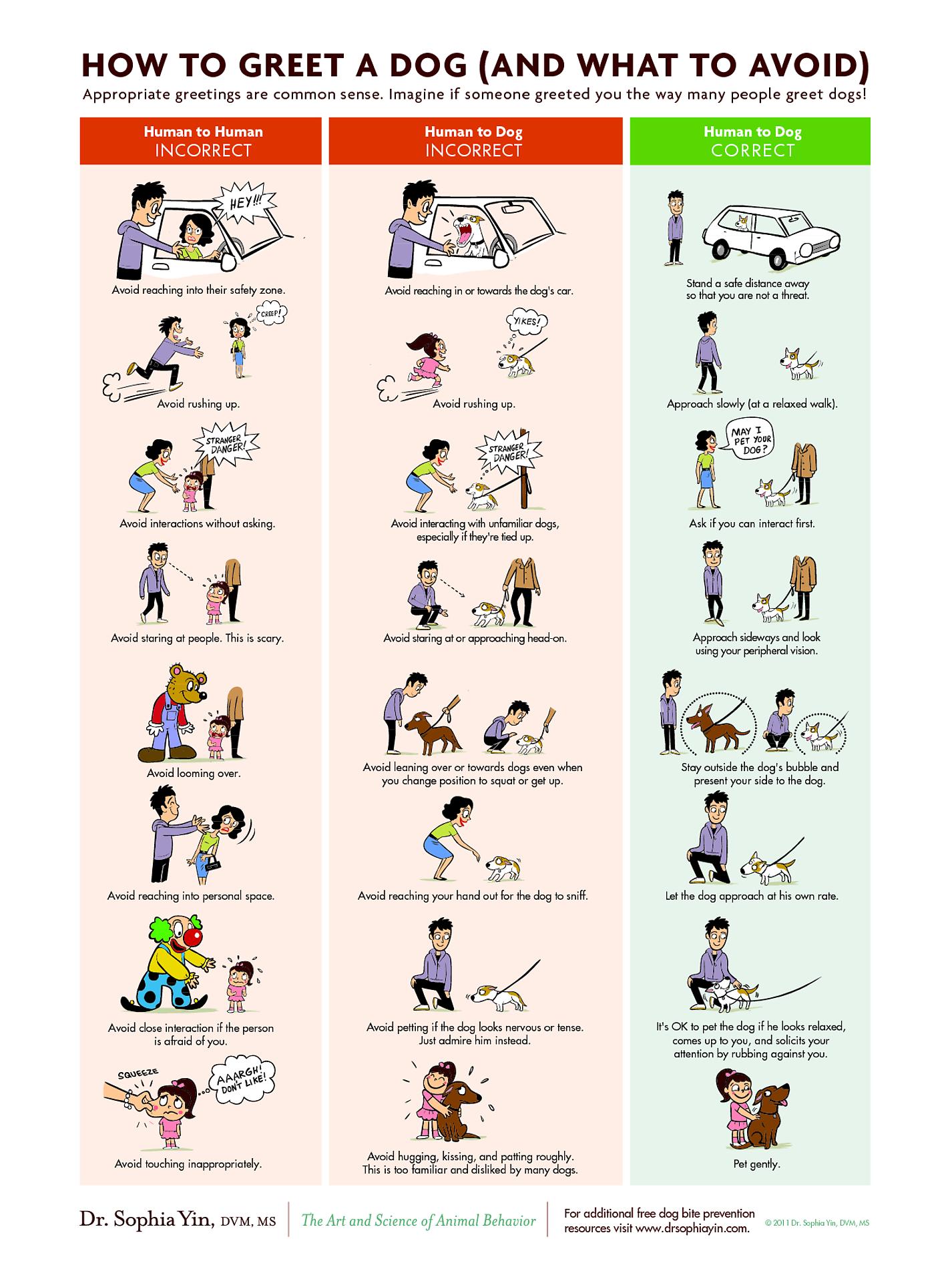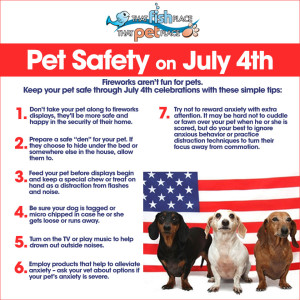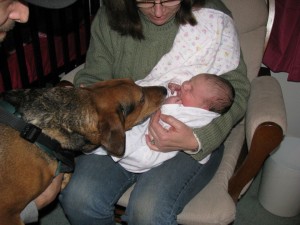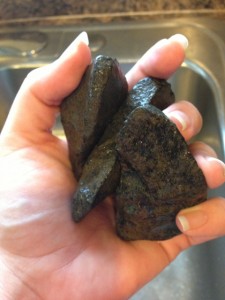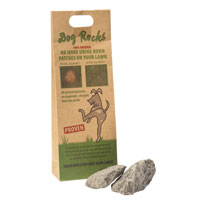You know that feeling you get every time you see a new dog? That somewhat uncontrollable urge to run over scoop that pup up and snuggle it for hours. As tempting as it may be, think about it from the dog’s point of view, scary right? If a dog sees you as a threat they may feel like they have no choice other than to bite. Here are some tips on how to greet dogs in a non-threatening manner.
Category Archives: Pet Behavior
Feed SubscriptionJuly 4th Fun & Fireworks – Pet Anxiety & Safety Tips
The July 4th Holiday is upon us, and unfortunately it is one of the busiest times for animal shelters due to the overwhelming amount of dogs lost during the fireworks & festivities. The fireworks may be fun for us, for some of our canine friends it can be downright terrifying.
During fireworks displays, or even while setting off fireworks in your backyard and neighborhood, your usually calm family pet may become extremely stressed. The stress overload can cause some pets to try to escape the house or yard. By following a few simple tips for this holiday weekend you can avoid coming home to an empty house and the anxiety of a missing beloved family pet.
- Avoid bringing your pet to fireworks displays, even if they are not usually startled by loud noises or thunder.
- Keep your pet indoors in a quiet, safe, sheltered area. Keep doors and windows closed and locked (I’ve heard stories of dogs opening slider doors or even jumping through windows to escape). Leave the TV on or play soothing music at a normal level to distract him from the noise outside
- Prepare a safe “den” for your pet. If they choose to hide under the bed, in their crate or somewhere else in the house, allow them to. If your dog is not crate trained, and you would like him to be please visit our comprehensive crate training guide.
- Feed your pet before the displays begin and keep a special chew treat on hand as a distraction.
- Nervous or stressed dogs may chew to ease anxiety. Make sure to provide proper chew toys and make sure all cords and other dangerous objects are out of reach
- Try a calming aid to help calm anxiety, or ask your vet for medication to help with your pet’s noise phobia.
- Do not leave your pet outside during the festivities. Even with a fence or a tie-out a dog can go to great lengths to escape the source of their anxiety.
- Always make sure your pet is wearing a properly fitted dog collar with up-to-date ID tags. Consider having your pet microchipped for extra security.
- Try not to reward anxiety with extra attention. It may be hard not to cuddle or fawn over your pet when he is scared, but do your best to ignore axious behavior or practice distraction techniques to turn their focus away from commotions.
Follow these simple steps to enjoy a worry free Independence Day. The knowledge that your family pets are safe and sound will make your holiday all the more fun. Have a great holiday weekend!
Severe Weather can also be very stressful on our pets. Check out this post for tips on keeping you pets calm during severe weather.
Dog Facts: 7 Things You Might Not Know About Your Canine Companion
Good day, Pet Blog Readers. Today we have an interesting article written by guest blogger Christian Wolb, from Hopi Animal Hospital in Scottsdale, Arizona. He has compiled a list of 7 fun facts you may not know about your dog. Some are fun behaviors, some are early indicators of potential health problems. Take a look, and if you have any fun facts about dogs that you would like to share, let us know in the comments section. Thanks!
_____________________________________________
How well do you know your dog sitting on your sofa? Why is he playing odd sometimes? Is your canine doing it on purpose or just desire to make fun of you? The days you are with your dogs do not guarantee how good you know them as well as their odd practices. Let’s try to find out some wonderful dog facts and know them more than what their wagging tail seems to tell.
Canine Fact Number 1: When your dog chases his/her tail, he might need help from the vet.
A wide variety of reasons clarify why dogs chase their tail: exercise, predatory instinct, discomfort or presence of fleas. Nevertheless, to talk with your vet is the safest and surest approach to get the actual reason why your dog keeps chasing his/her tail.
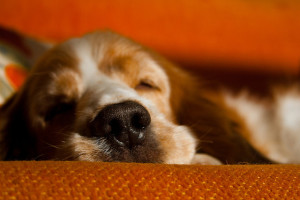 Canine Fact Number 2: Dogs dream while asleep.
Canine Fact Number 2: Dogs dream while asleep.
Do not be shocked if you see your dog barking or moving his/her feet while asleep. He/she may have been chasing his/her dearest at the park in his/her dream. Humans and dogs share the same SWS (slow wave sleep) as well as REM (rapid eye movement) while asleep. So let him/her experience the moment to savor twitching while the eyes are closed.
Dog Fact Number 3: They have night vision.
Do you know how dogs can freely move in the dark? How did they even get robbers trying to steal your valuables when it’s dark? Well, dogs have tapetum lucidum, which gives them the ability them to see even when it’s dark.
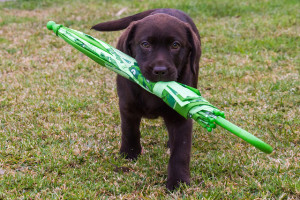 Canine Fact Number 4: If he/she is acting comical, go find your umbrella.
Canine Fact Number 4: If he/she is acting comical, go find your umbrella.
Although scientists have not yet found the mystery behind this, but according to some, dogs can determine the weather especially when it’s going to rain. So, the next time you discover your dog acting funny, go get the umbrella straight away. Besides, it pays to be all set at all cost.
Dog Fact Number 5: Dogs don’t sweat like we do.
Dogs do not sweat everywhere. As a matter of fact, they only sweat on their pads. When you find that their paw pads are sweating, you get the notion that the area is a bit warm for them to reside.
Dog Fact Number 6: Your dog’s nose is wet because he/she is absorbing scent.
Popularly known to be the captain of scent, dogs secrete a mucous on their nose to help them recognize the scent (more accurately than we do). When their noses get wet, they would lick them to sample the scent they have gathered with their mouth.
Canine Fact Number 7: They are the chief of scent.
Dogs can smell 100,000 times more accurate than their owners. No wonder why even the FBI and peace order departments of our local government search help from them in searching unwanted items in certain public places. This also explains why when you leave your cookies unattended; you would be left with nothing but the food container.
There are other things that you do not understand about your pet so do not easily label them by the way they act or kick after peeing in your couch. Some of the strange stuffs they do may really be funny but it is always ideal to visit your vet on a regular basis.
Author’s bio:
Do you want to know more about your pets? Visit http://www.hopianimalhospital.com/ and discuss your pet concerns with people dedicated to provide pet care services for the wellbeing of your pets.
Dogs and Babies: Tips for Introducing Your Pet to Your Newborn
When my husband and I were expecting our first child, part of our preparations included getting Chester (our 6 year old hound dog) ready for the baby. We have all been told to bring something home from the hospital with the baby’s scent on it but did you know there are other ways you can help prepare your dog for their new little brother or sister?
Set Up The Stuff
Babies come with tons, and I mean TONS, of stuff. You can help your dog prepare by slowly putting the new items out. Set up your crib one day and then that fancy new swing or play mat a few days later. Take it slow and let him get used to each item before adding the next. Introducing these items gradually will give your dog a chance to smell and explore each one, and then when your baby arrives he will already be used to those things being in the house.
Bring Babies Around
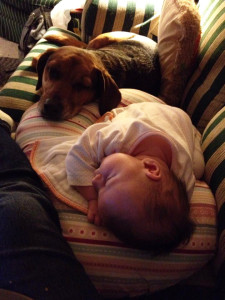
Have friends with babies? Have them over. If your dog has never been around a baby you may want to see how he reacts to the crying and all the new little movements. Some people have even used those electronic babies you were forced to bring home from health class. Lucky we have lots of family and friends with kids, so Chester has had exposure to children of all ages.
Set Boundaries
Let your dog know what’s okay and what’s not. If he won’t be allowed in the nursery after the baby comes, don’t let him in now. If you let him do things now that you won’t let him do when the baby arrives it’s going to confuse him and he could end up resenting you or your little one.
Tell Him About The Baby
Everyone says that dogs can tell when you are pregnant and I really believe that Chester knew. It might sound silly to a non pet owner, but I talk to Chester like he’s my best friend so naturally I told him all about his little sister before she arrived. I like to think he understood and that helped him prepare.
Stock Up On Treats And Toys
In the weeks after you bring your little one home your front door will be like one of those revolving doors at the mall, people coming in and out all the time. Chester is extremely food motivated, so we stocked up on lots of different types of treats. We got some of his favorite training treats to reward him for good behavior or if we needed to temporarily distract him from the door or other items. We also loaded up on some long lasting treats like Greenies , filled bones, and Indigo chews. These were good to have when he would get a little too excited and we needed to divert his attention for a longer period of time. If you are worried about over treating or your dog is on a diet, toys can also be used to keep your pup occupied.
Have A Plan
This may be common sense but make sure you have a reliable pet sitter on call. Child birth is unpredictable–you can go into labor at any time and be in the hospital for an undetermined amount of time. Make sure you have one, if not two, pet sitters that will be able to get your dog within a few hours when the big day comes.
Control The Introduction
Chances are that you haven’t seen your dog for a few days, so he is going to be really happy to see you. Give him a little time to get his excitement out and give you all the kisses he wants before bringing in the baby. What worked for us was to have my mom take Emmalynne into her nursery when my husband brought Chester home. Once he was over the excitement of seeing me he sniffed around at the diaper bag and car seat then we took him in to meet his little sister.
Keep Calm
Your dog can tell if you are nervous and that can make him uneasy, if you stay calm and don’t make a huge deal out of him meeting the little one he won’t either. Remember to take it easy on your pup; this is a huge adjustment for him too. Dog toys and baby toys are surprisingly similar so you can’t really blame him for chewing on one you leave out.
Don’t Forget Your Dog
Make sure your dog gets enough exercise and attention. Try to stick with his normally scheduled feedings and walks; you don’t want to have to deal with accidents just because you didn’t have time to let him out. We take Chester with us everywhere that we are allowed to. So even though it might be easier to leave him home sometimes, we make sure that if we would have taken him before Emmalynne was born, we take him now. I look at it more like; we now have two kids rather than one kid and a dog.
These are some of the things that helped Chester make the transition from only child to older brother. Emmalynne is now two months old and Chester has taken on the role of her protector. When someone new holds her he is watching their every move. He is more alert and curious about abnormal noises. In the mornings when she’s in our room sleeping and I’m getting ready he lays in the doorway where he can keep an eye on both of us. It makes me feel good knowing that he is looking out for her (as all big brothers should). I think he has accepted her as a member of our family and I am excited to see how their relationship grows as she gets older!
Top 3 Crate Training Questions, Answered
 Continuing our series on crate training, this segment will answer some of the top questions we get when people are considering crate training their dogs or puppies. Our previous posts included why you should consider crate training and the three main steps for crate training your dog. Hopefully by now you know that crate trained dogs don’t view their crates as punishment, but as a refuge in a world that is constantly changing around them. You also know that crate training can be a slow process. That leads us to our first question:
Continuing our series on crate training, this segment will answer some of the top questions we get when people are considering crate training their dogs or puppies. Our previous posts included why you should consider crate training and the three main steps for crate training your dog. Hopefully by now you know that crate trained dogs don’t view their crates as punishment, but as a refuge in a world that is constantly changing around them. You also know that crate training can be a slow process. That leads us to our first question:
How Long Will Crate Training Take?
The answer to this very common question is “It depends.” It depends on your dog’s age, temperament, personality, and any past experiences they may have had in a crate.
It is very important not to rush the process of crate training. Take your time and only proceed when your dog is comfortable with the last step in the training process. If you move too fast, your dog may become anxious or fearful of the crate. The purpose of your dog’s crate is to provide a safe, comfortable environment where your dog can retreat to if they are anxious, scared, or there is too much excitement in the house.
The crate should always be a safe, welcoming and enjoyable environment, which is why you should never use the crate as a tool for punishing bad behavior. Make sure to provide plenty of treats, praise, fun toys, and love while you are crate training. Your dog will learn to enjoy time in the crate and will begin to use it on his own, without you asking him to go to his crate.
The second most common question we hear has to do with whining. Many puppies have this issue in particular and it can be heart wrenching to listen to. Lets talk about some steps to try if your dog is whining while they are inside their crate.
What do I do if my dog is whining?
You never want to let your dog out of the crate when they are whining. This only serves as a “reward” and they’ve now learned that whining will get them out of the crate. Consider first that your puppy may be whining because he needs to go to the bathroom. Calmly take him straight outside to do his business and return him to the crate without any stops along the way.
Read More »
5 Things You Give Up In Exchange for Pet Parenthood
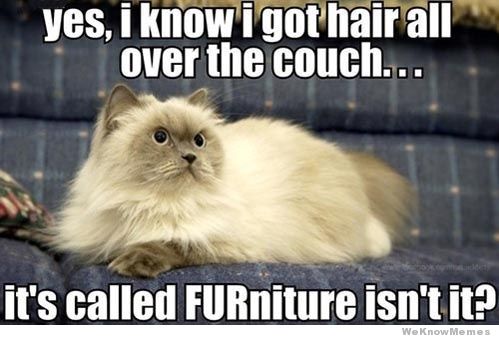 Lots of people I know don’t have pets because they’re afraid that a pet might destroy their belongings or otherwise cause destruction and mayhem. While this is definitely the case with some pets, there are steps you can take to mitigate the damage and take on a furry family member. The love that you receive from a cat or a dog in the house is unlike any other kind of love you’ll ever experience. It is an experience to cherish and hold dear, though I heartily admit pet ownership isn’t right for everyone.
Lots of people I know don’t have pets because they’re afraid that a pet might destroy their belongings or otherwise cause destruction and mayhem. While this is definitely the case with some pets, there are steps you can take to mitigate the damage and take on a furry family member. The love that you receive from a cat or a dog in the house is unlike any other kind of love you’ll ever experience. It is an experience to cherish and hold dear, though I heartily admit pet ownership isn’t right for everyone.
Without further ado, here are my top 5 picks for what pet parents sacrifice:
1. Clothes or furniture free of dog hair or cat hair
This one is tough to avoid at all costs, unless you decide on a hairless breed of cat or dog, but trust me; a house full of pets is a house full of loose fur! I have 3 dogs and 2 cats and I sweep and vacuum twice a week, which is probably less than half of what I should do. When you share your home with this many animals you learn to ignore the hair as much as possible. Some tips for tackling that hair problem?
- Soft leather furniture. I’ve had 2 cloth sofas and I now have a soft leather couch. By far, there is much less hair on the leather couch than on the previous sofas. You’ll have to mindful of claws and get high quality leather, but leather is much easier to clean than a cloth sofa.
- Regular grooming. The more hair you can remove with regular brushing and dog grooming means fewer hairs on your clothes! I groom weekly, but should do it more often.
- Use the hair as a condiment or garnish. My mother in law always said “Nothing tastes quite right without a Husky hair in it, or two!” I’m sure from an outsider this sounds gross, but fellow pet lovers can probably attest, there is no way you’re going to be completely hair free in your house.
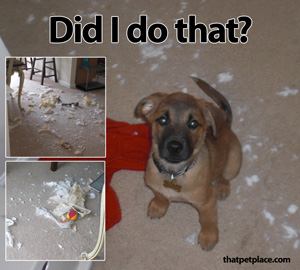 2. Nice belongings.
2. Nice belongings.
Especially the case with young dogs, they will love to chew and they will inevitably find your favorite pair of expensive heels to chew on! My opinion is that every dog is different, some dogs I’ve had went after personal belongings, others chewed on furniture. There are ways to keep your pet from taking everything you love:
- Keep nice things (handbags, shoes, baskets, electronics) out of reach and behind closed doors.
- Use bitter apple spray on your furniture
- Adopt an older pet who is less likely to damage your belongings. Be sure to find out from the shelter staff if there are any known “chewing” incidents.
- Create a pets-only room: A room where you pet can roam unsupervised with plenty of toys, beds and chews to occupy their minds while you’re away.
Why Does My Cat Do That? – Common Questions on Kitty Behavior
 You know your pets better than anyone, but even though you love them no matter what, their adorable and often mystifying behaviors may sometimes make you ask “why do you do that”? Here are some simple answers to common questions on cat behaviors you may witness every day.
You know your pets better than anyone, but even though you love them no matter what, their adorable and often mystifying behaviors may sometimes make you ask “why do you do that”? Here are some simple answers to common questions on cat behaviors you may witness every day.
Why does my cat purr?
Your cat’s purr may be one of your favorite things about hime or her. Where that distinctive sound originates is still debated, but cat owners know that unmistakeable trill, which begins when the cat is about a week old. Cats purr when they are content and happy, but also when they are stressed by fear or pain. The frequency of the purr has been linked to stimulated bone growth and healing, and it is also believed that endorphins are released while the sound is produced. So, despite the obvious communicative properties of a good healthy purr, it may actually be contributing to your pet’s overall well-being, as a self-soothing, self-healing, relaxing therapy. You probably already know that a purring cat can have similarly soothing, healing, relaxing powers on you too!
Why does my cat knead me with his paws?

Learning to Speak Cat: What Your Kitten’s Behavior Is Trying to Tell You
 Kittens are cute. It is an undeniable fact that the little balls of soft fur that are clumsy in their own kittenish way are probably one of the cutest animals on the planet. When you bring the kitten home, you may be thinking that there is nothing to know about raising cats as they are often portrayed as being pretty self-reliant.
Kittens are cute. It is an undeniable fact that the little balls of soft fur that are clumsy in their own kittenish way are probably one of the cutest animals on the planet. When you bring the kitten home, you may be thinking that there is nothing to know about raising cats as they are often portrayed as being pretty self-reliant.
Cats, however, do talk to you and you should have an understanding of what they are trying to say. These communications are not always going to be verbal displays, they will also include the animals’ mannerisms, or how it presents itself.
Punishments
You may be tempted to try disciplining your kitten in order to break it of any bad habits that may be present. Some suggest making a loud noise by either clapping or banging something, while others suggest using a spray bottle to stop undesirable behaviors.
Whichever method you choose you will want to be sure that you never shake, yell at, or kick the kitten. Kittens, much like human babies, are incredibly delicate. Shaking, hitting, or kicking the kitten can cause serious problems. You will also want to be careful to avoid doing things that cause your kitten to become skittish or afraid of you.
Read More »
Do Dog Rocks Work to Prevent Urine Burn? A Dog Rocks Review
In post earlier this week, I explained what Dog Rocks are and how they claim to eliminate new urine burn spots on your lawn. I used them for 30 days and here is what I found:
I’m not sure what I expected, but I removed the Dog Rocks from the package… and they were plain looking rocks. Maybe I expected them to feel magical or mysterious in some way, but no, just igneous rock from a special site in Australia.
[Mini Geology Lesson: Igneous rock is one of the 3 main types of rock found in the Earth’s crust. It is formed through the cooling of magma (lava). The conditions of the cooling magma (if it is under a lot of pressure, if it cools very fast or very slow, etc) determine the specific properties of the rock (how porous it is, color, texture). ]I rinsed them and placed them in the filter housing area of my dog water fountain so that my pups wouldn’t be tempted to remove and chew on the rocks. Then it was just a waiting game.
These are the photos of the areas where my dogs usually eliminate on day 1:
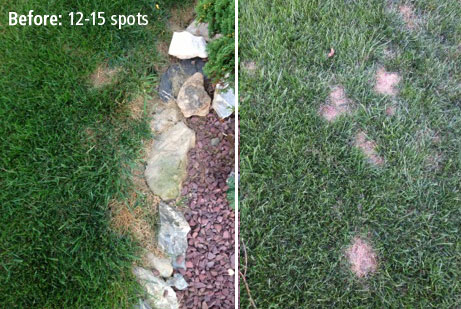
2 main areas of my yard before using Dog Rocks
Here are the photos of the same areas on day 31:
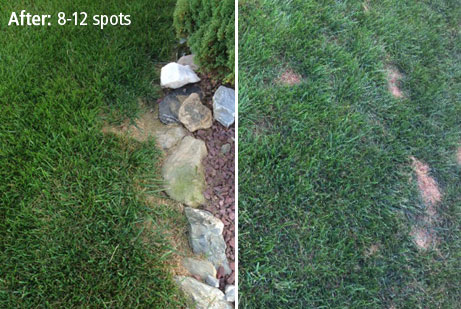
Same areas of the yard after 1 month of using Dog Rocks
My opinion: Do dog rocks work?
While I admit that my results weren’t as amazing as the photos on the packaging suggest, I definitely do see an improvement. My dogs go to the bathroom in the same area of the yard day after day, so there aren’t spots anywhere else on my lawn from my own dogs. Dog Rocks won’t cure the already existing burn spots, so I was looking for new burn patches in these areas. Instead, what I see is my grass growing back into the previously burnt areas, and no clear evidence of new burn spots. Again, this is only after 1 month. I’ll continue to use them and hopefully by spring I’ll have a lush green lawn like my neighbors 🙂
A couple of notes:
- I conducted this test in August, which isn’t exactly the best month for growing new grass in our area. Dog Rocks won’t cure the already existing urine burns, freshly grown grass will eventually fill in the spots. You can speed up the process by tilling the burnt areas and planting new grass seed. I prefer to let the lawn do the hard work.
- Diet plays a major role in the amount of nitrates in your dog’s urine. I feed a pretty high protein, home cooked diet because my dogs are highly active. Choosing a high quality dog food with appropriate protein levels for your dog is a key component in controlling lawn burn.
- Dog Rocks need to be replaced every 2 months and one packet of rocks should be in each water bowl that is available to your dogs for the best results.
Because I have three dogs and a pretty small yard, my results might not be typical. Pick up a package of dog rocks and give them a try for yourself. They’re all-natural, they won’t harm your pet (so long as they don’t eat the rocks), they’re inexpensive compared to other additives and alternatives, and they might help prevent unsightly urine burn patches on your lawn. Find Dog Rocks at the lowest price online at thatpetplace.com!
Preventing Lawn Urine Spots: What are Dog Rocks and How Do They Work?
If you have dogs and you like to keep a nice green lawn, you probably have tried every remedy in the book to prevent those unsightly urine burn patches in the area where your dog pees. There’s a new product in town that claims to prevent your dog’s urine from burning your lawn when used as directed.
Dog Rocks USA was kind enough to provide me with a sample of their product to try and review. Up front, let me tell you that I was skeptical that rocks could help me in my battle of the brown spots in my lawn. First, let me straighten a few things out:

Lawn burn cause by my boys’ leg lifting near the edge of my garden.
- Dog Rocks are not going to rid your lawn of existing urine spots, but is intended to prevent new spots. This is an important distinction.
- Dog Rocks do not change the pH of your dog’s urine (which can be harmful, especially to dogs with kidney disease)
- Diet also plays a key role in how many urine burn patches you have on your lawn. A diet very high in protein creates more nitrogen in your dog’s urine. Feed a high quality diet for the best results. Dog rocks will not alter the amount of nitrogen (nitrates) your dog produces naturally.
After that last point, you may be wondering how Dog Rocks work
Read More »
 That Pet Blog That Pet Place Pet Blog
That Pet Blog That Pet Place Pet Blog

